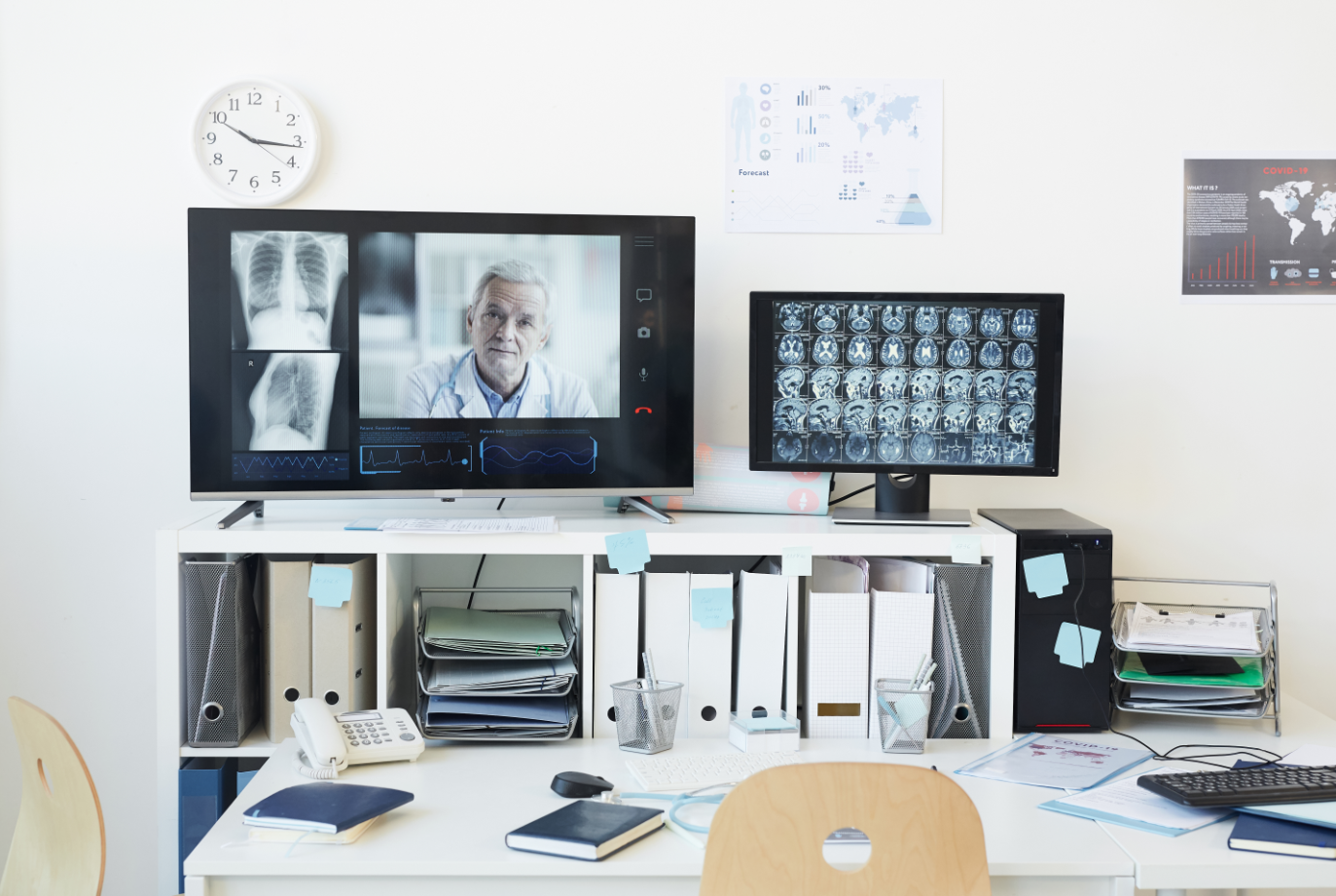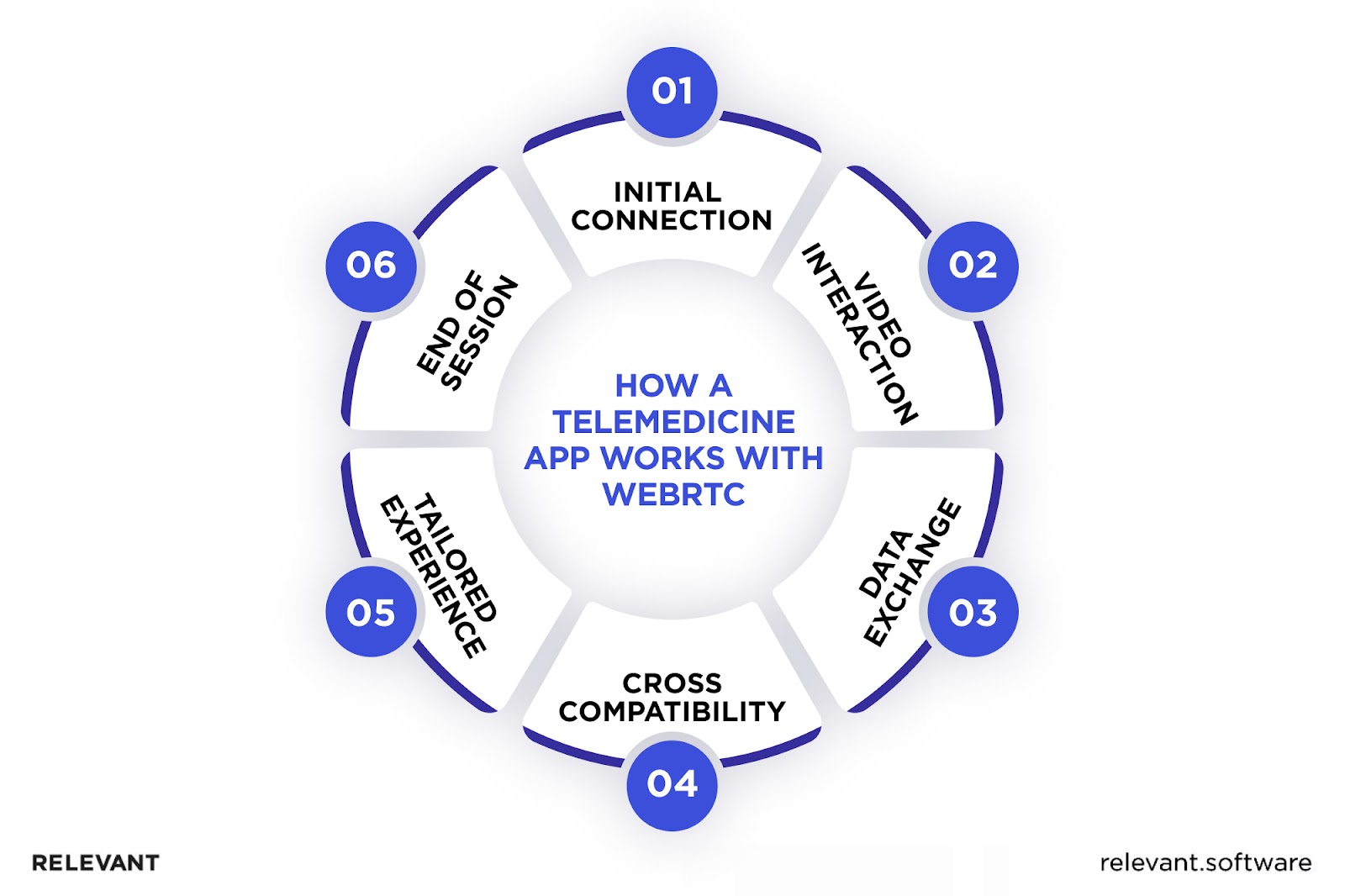How does a Telemedicine App Work with WebRTC?
Updated: June 4, 2025
Did you know that over 38% of patients who received care have used some form of telemedicine in 2022? But what really goes on behind that user-friendly interface of telemedicine apps? Beneath the surface, a world of protocols, connections, and technologies come together known as WebRTC. When you’re conversing with a doctor across a screen, it’s WebRTC Telemedicine that’s diligently working in the background, ensuring that the connection is seamless and secure.
This innovation is quietly revolutionizing telemedicine, transforming distant exchanges into intimate conversations, almost as if you’re in the same room. With the recent boom in remote visits, understanding WebRTC’s telemedicine role becomes paramount for any healthcare professional, stakeholder, or enthusiast keen on health tech advancements.

We provide companies with senior tech talent and product development expertise to build world-class software. Let's talk about how we can help you.
Contact usReady to be enlightened about how WebRTC is shaping modern telemedicine? Let’s check it out.
Table of Contents
What is Telemedicine?
Have you ever had those moments when getting to a doctor felt like a logistical nightmare? Or when a specialist you needed was cities away? Telemedicine shifts those difficulties into afterthoughts. Using technology, it brings healthcare professionals and patients together, no matter where they’re located.
It’s like having a medical consultation over a video call. It’s not about replacing traditional healthcare but enhancing it. From rural areas with limited access to specialists to urban dwellers with packed schedules, telemedicine offers a convenient alternative. And the best part? It’s not just limited to consultations. Prescriptions, follow-ups, and even some diagnostics can now be handled remotely.
Your Next Read: How Does Telemedicine Work

Benefits of Telemedicine
Let’s be real; the traditional doctor’s office visit isn’t always a walk in the park. Scheduling, wait times, commute – these elements can sometimes turn a simple check-up into an all-day event. Telemedicine steps in, offering a fresh approach to healthcare that addresses many of these inconveniences.
First off, there’s the sheer accessibility. Live in a remote village or on the top floor of a bustling city high-rise? No problem. Telemedicine ensures that a quality healthcare consultation is as close as your device screen. This digital shift is a boon, especially for those in areas where medical specialists might be scarce.
Then, consider the convenience. No more adjusting your day around doctor’s appointments. With telemedicine, healthcare fits into your schedule, not vice versa. Whether it’s a quick chat during your lunch break or a late-night consultation, it’s healthcare tailored to your timetable.
And let’s talk about cost savings. While telemedicine doesn’t replace every doctor’s visit, it can certainly help cut down on some of them. Fewer in-person visits mean fewer transportation costs and less time off work. Plus, many telehealth platforms offer competitive consultation rates compared to traditional clinics.
Lastly, telemedicine allows for more consistent follow-ups. Got a query post-consultation? Simply log in and chat with your healthcare provider. It’s this continuous care model that ensures patients remain at the heart of the healthcare process.
What is WebRTC?
Now, let’s dive into WebRTC. Imagine wanting to catch up with a friend over video chat. You’d probably think of downloading an app. WebRTC asks, “Why download an app when you can do it directly from your browser?”
At its core, WebRTC, which stands for Web Real-Time Communication, is a technology that allows audio, video, and data sharing directly between browsers without needing an intermediary, like a separate software or app. Think of it as a bridge that connects two devices, letting them “speak” to each other in real-time, all through the possibilities of the Internet.
Now, you might wonder, “Why should I care?” For one, it cuts down the fuss. No need for third-party software or plugin installations. It’s streamlined, efficient, and, frankly, quite cool. Especially for telemedicine, WebRTC provides that essential link, enabling doctors and patients to connect effortlessly.
But beyond its convenience, healthcare app development with WebRTC has another ace – it is built with security in mind. Those conversations between browsers? They’re encrypted, ensuring your discussions, especially confidential medical ones, stay private.

Why WebRTC is Crucial for Best Telemedicine
The healthcare sector is not known for adopting every tech trend that passes by, and rightfully so. Patient care and data security are top priorities; any tech adoption needs to align with those imperatives. So, when you see the health tech community rallying behind WebRTC for telemedicine, it’s not a short-lived interest; it’s a calculated decision.
First up, let’s talk about security. In an age where data breaches are as frequent as morning coffee, WebRTC provides end-to-end encryption. This ensures that confidential doctor-patient interactions remain just that—confidential. When a patient discusses symptoms, medical history, or any other personal details, they want to be certain that any prying eyes won’t intercept their information. WebRTC delivers on this front.
It is especially crucial for telehealth services in the US. While platforms like Skype and FaceTime might be popular for conversations, they don’t meet the HIPAA bar, making them a no-go for telehealth endeavors.
Next, there’s the sheer accessibility of WebRTC. The strong point of this technology is its compatibility. Whether you’re on a laptop in New York or a tablet in Tokyo, WebRTC ensures that telemedicine apps function seamlessly across devices and browsers. It levels the playing field, making high-quality healthcare interactions available to anyone with an Internet connection.
Lastly, the “real-time” in WebRTC isn’t just a catchy phrase. In critical medical situations, every second counts. The ability to instantly connect with medical professionals without lags can be, in some scenarios, lifesaving. When a doctor can see symptoms in real-time or a therapist can instantly assess a patient’s behavior it elevates the quality of care delivered.
In essence, while there are many technologies advertising their benefits, WebRTC services in healthcare genuinely address the unique challenges and requirements of the telemedicine world. It’s not just about making things work; it’s about making them work in the best way possible.
How a Telemedicine App Works with WebRTC
When it comes to pairing telemedicine software with WebRTC, it’s like fitting together two pieces of a well-designed puzzle. But what exactly happens behind the scenes? Let’s clarify this.

- Initial Connection: Telemedicine software platforms’ solution typically starts with an authentication process. A patient logs in, maybe fills out some preliminary health details, and sets up a consultation. Here, WebRTC jumps into action. It ensures that the connection between the patient and healthcare professional is not just fast but also secure.
- Video Interaction: The core feature of most telemedicine software is video chat. This is where WebRTC truly shines. It facilitates high-quality video and audio communication, ensuring that both parties can see and hear each other clearly, replicating the experience of an in-person consultation.
- Data Exchange: Often, during a session, there might be a need to share medical reports, images, or documents. WebRTC ensures that this data exchange happens seamlessly without compromising the ongoing video session.
- Cross-Compatibility: With a diverse range of devices in use today, telemedicine software features must be compatible across the board. WebRTC ensures that whether the patient uses a mobile device, desktop, or tablet, the experience remains consistent.
- Tailored Experience: For those looking for something more specific to their needs, custom telemedicine software solutions can be integrated with WebRTC. This allows for specialized functionalities like group consultations, integration with electronic health records, or any other bespoke requirement.
- End of Session: Once the consultation is complete, WebRTC ensures that the session is closed securely. Any health data sharing or discussion remains confidential.
Setting Up a Telemedicine Consultation with WebRTC
Step into the digital consultation room for a moment. Setting up a telemedicine consultation using a WebRTC-enabled app isn’t as tech-heavy as you might think. Let’s walk through the process:
| Process Step | Description |
| User Registration | Patients begin by creating an account. They enter basic details and may include their medical history or current symptoms. This gives doctors an immediate context. |
| Selecting the Right Specialist | Most apps present a list of available specialists or GPs. Patients can make choices based on specialty, experience, or patient reviews – much like navigating a virtual hospital. |
| Appointment Booking | After selecting a doctor, patients can view available time slots and pick one that suits their schedule. |
| Notifications & Reminders | Automated notifications are dispatched to both the doctor and patient, ensuring they’re reminded of the upcoming consultation. |
| Secure Connection | When it’s time for the consultation, the telemedicine software platform’s solution with WebRTC facilitates a secure, seamless connection, eliminating the need for extra downloads or plugins. |
This table simplifies the patient’s journey through a telemedicine app, making the process easy to understand at a glance.
Real-time Patient-Doctor Interactions Through WebRTC Telemedicine
Imagine having a face-to-face chat with your doctor from the comfort of your couch. That’s the essence of a WebRTC-based telemedicine interaction. Here’s what the experience feels like:
| Interaction Features | Detailed Explanation |
| Seamless Video and Audio | When the consultation begins, it feels almost instantaneous, mirroring a natural conversation. The audio clarity is unmatched, and the video quality is impeccable. It’s comparable to an in-person chat in the comfort of one’s living room. |
| Screen Sharing | At times, doctors need to dive deep into medical diagrams or records. Thanks to WebRTC, they can effortlessly share their screen, ensuring everyone’s viewing the same information and there’s no room for misunderstanding. |
| Annotations & Pointers | If a physician needs to emphasize a section of an X-ray or document, annotation features of telemedicine apps come to the rescue. They can easily mark or point out specific areas, ensuring patients fully grasp the context and details. |
| Recording (with Consent) | Sometimes, for future reference or clarity, sessions might be recorded — but only with the patient’s explicit permission. This aids both in revisiting advice and for professional documentation. |
| Instant Messaging | Should there be any hiccup in the audio or for sharing quick resources and notes, a chat feature is available. This ensures that communication remains uninterrupted and supplements the video interaction. |
| Secure Disconnect | The same priority given to beginning the session securely is afforded to its conclusion. Once the consultation is over, the connection terminates with assured privacy, leaving no trace or vulnerability behind. |
In a nutshell, integrating WebRTC with a telehealth app within healthcare web development isn’t about simply adding a video chat feature. It’s about enhancing the overall user experience, ensuring that the patient and healthcare provider have a productive, efficient, and secure interaction. For the health tech community, it’s about taking steps in the right direction and optimizing patient care in the digital age.
Ensuring Security and Privacy in WebRTC Telemedicine Apps
When diving into the digital world of telemedicine, there’s an elephant in the room we cannot ignore: data security. With the intimate nature of medical information and the sensitivity of patient details, balancing accessibility with iron-clad security is no small feat in building custom telemedicine software solutions. Yet it’s precisely what’s demanded in this ever-expanding field.
Importance of Data Security in Telemedicine
Imagine a world where medical consultations happen over coffee chats, and diagnoses are whispered across diner tables. Sounds pretty unprofessional and risky, right? This is precisely how lax data security in telemedicine might appear. The risks are genuine and manifold. From identity theft and fraudulent billings to the emotional and psychological impact on patients, data breaches have profound consequences. Ensuring stringent data protection isn’t just about adhering to regulations—it’s about honoring the trust patients place in healthcare providers.
How WebRTC Helps in Maintaining Privacy and Security
For starters, WebRTC ensures that all communication is end-to-end encrypted. This means that nobody, not even the service provider, can eavesdrop on the consultation. Additionally, WebRTC eliminates the need for downloads or plugins, reducing the potential avenues for security breaches.
Moreover, WebRTC adheres to strict security standards, utilizing technologies such as DTLS (Datagram Transport Layer Security) and SRTP (Secure Real-Time Protocol) to safeguard data transmission. When integrated within telemedicine apps, WebRTC provides not just a platform for seamless interaction but also a security blanket, ensuring that patient histories stay exactly where they should be—between the doctor and the patient.
The blend of convenience and security that WebRTC offers makes it an invaluable asset in the telemedicine toolkit, ensuring that healthcare remains both personal and private.
WebRTC Telemedicine: Final Thoughts
While we’re genuinely enthusiastic about the potential of WebRTC and its prospective transformation of telemedicine specialty services, it’s vital to acknowledge that it isn’t a one-size-fits-all remedy. No technology, no matter how advanced, serves as an absolute answer. Yet, weighing the features of telemedicine apps and the benefits and drawbacks of telehealth, we’d confidently predict that, before long, you, too, will be experiencing a WebRTC telehealth app conversation.
As you ponder how to build a telemedicine application using WebRTC, why not engage with experts who breathe this technology daily? Contact Relevant Software for precise healthcare IT consulting services on WebRTC application development tailored to the healthcare domain. With proficiency in building WebRTC telemedicine solutions, we ensure that the complexities are unraveled, making healthcare software development seamless and impactful.
FAQ
Our core services:
Do you want a price estimate for your project?
Do you know that we helped 200+ companies build web/mobile apps and scale dev teams?
Let's talk about your engineering needs.
Write to us











